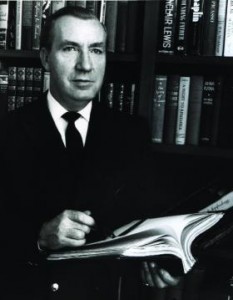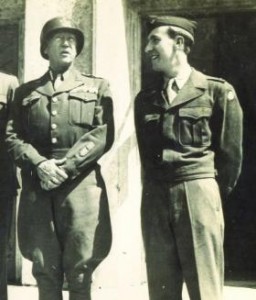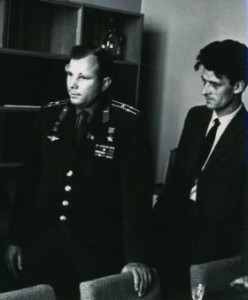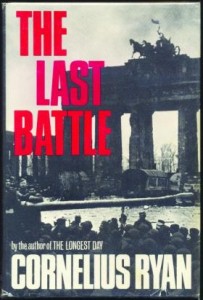Cornelius Ryan and the battle for the Kremlin archives
Published in 20th-century / Contemporary History, Features, Issue 3 (May/June 2010), Volume 18
Cornelius Ryan—became a household name as a ‘popular historian’ after the huge international success of his 1959 D-Day book The longest day. (Dominic Phelan)
In the wake of the success of The longest day, the pressure on Dublin-born ‘narrative historian’ Cornelius Ryan to produce a worthy successor was enormous. Initially he planned to tackle the disastrous battle for Arnhem, but the Soviet invitation to view their military archives in Moscow shifted his attention to the Battle for Berlin. He knew he had to act quickly as this ‘Khrushchev thaw’—an early pre-Gorbachev experiment in openness—might not last long:
‘I estimated that it might take a full ten years before the Soviets relented and allow Western eyes to see their World War II documentation. I wrote a score of letters to the Soviet authorities—never once believing that they would answer them.’
The only pre-condition the Soviets placed on Ryan’s research trip was that he couldn’t bring along another American. When the head of the Soviet Academy of Sciences military history department suggested bringing John Erickson (a young English academic at the University of Manchester) as a translator because he knew ‘more about our armed forces than we do’, Ryan agreed even though he didn’t know him personally. Luckily Erickson’s book The Soviet High Command was well respected by those who had access to it in the ‘restricted’ section of Moscow’s Lenin Library, so Reader’s Digest, which was funding the research trip for serialisation rights, quickly signed him up before the Soviets could change their minds. These fast-moving developments would have negative consequences for fellow American narrative historian John Toland, who was also making his way to Moscow to research his own book on Berlin.
Clash of cultures
 Ryan and Erickson flew into Moscow in mid-April 1963 on a three-week research trip that would quickly become a ‘clash of cultures’ on all sides. Unfortunately, Ryan had a deep distrust of the Soviets ever since he had encountered Red Army troops in Prague whilst covering General Patton’s advance through Europe for the Daily Telegraph. In Moscow his own worst prejudices seemed confirmed when they were immediately informed that they would not, as hoped, be met by famed Marshal Georgi Zhukov. Even though there was a post-Stalin thaw in progress, the Kremlin establishment was still afraid of the general’s immense popularity with the people and were determined not to give him a starring role in any bestselling western history book. Ryan’s approach to dealing with the secretive Soviets also wasn’t helped by a pep talk he had received from Kennedy, during which the president had urged the writer to be tough with the Russians because ‘at heart they were horse traders’. Ryan later acknowledged that his methods were ‘not always as diplomatic as they might have been’. According to Ljubica Erickson, the English historian’s wife, herself an accomplished expert on the Soviet military,
Ryan and Erickson flew into Moscow in mid-April 1963 on a three-week research trip that would quickly become a ‘clash of cultures’ on all sides. Unfortunately, Ryan had a deep distrust of the Soviets ever since he had encountered Red Army troops in Prague whilst covering General Patton’s advance through Europe for the Daily Telegraph. In Moscow his own worst prejudices seemed confirmed when they were immediately informed that they would not, as hoped, be met by famed Marshal Georgi Zhukov. Even though there was a post-Stalin thaw in progress, the Kremlin establishment was still afraid of the general’s immense popularity with the people and were determined not to give him a starring role in any bestselling western history book. Ryan’s approach to dealing with the secretive Soviets also wasn’t helped by a pep talk he had received from Kennedy, during which the president had urged the writer to be tough with the Russians because ‘at heart they were horse traders’. Ryan later acknowledged that his methods were ‘not always as diplomatic as they might have been’. According to Ljubica Erickson, the English historian’s wife, herself an accomplished expert on the Soviet military,
‘

A young Cornelius Ryan with General George S. Patton in 1945. Ryan had a deep distrust of the Soviets ever since he had encountered Red Army troops in Prague whilst covering Patton’s advance through Europe for the Daily Telegraph. (Dominic Phelan)
When Cornelius was in Russia he was insensitive because he didn’t really know the Soviet Union. John had to diplomatically extricate Ryan on a number of occasions because he was very forthright and combative. He didn’t broker much opposition and during those moments John had to calm things down.’
Ryan’s first major gaffe had been to ask questions about General Vlasov, a Russian commander who had formed an army of Soviet prisoners to fight with the Germans against the Red Army. Even today Vlasov is still reviled in post-communist Russia, so pressing the issue during the height of the Cold War was a serious mistake and Erickson had to talk their way out of it all before permanent damage was done. When the Soviets realised that the two historians could be steered away from politically embarrassing subjects, they finally opened up and produced a steady stream of legendary figures, including Marshal Koniev, commander of the first Ukrainian front; Marshal Rokossovsky, commander of the second Belorussian front; tank corps commander Major-General Yushchuk; and rifle division battalion commander General Samsonov, whose men had captured the Reichstag.
’Once we had started, the difficulty was in getting them to stop talking’, is how Erickson described these face-to-face talks. ‘The interviews went on not merely for hours but for days.’
Paris and Dublin
Throughout their three-week stay the pair were based at the grandiose Hotel Metropol overlooking the Bolshoi Ballet, but there was little time for sightseeing. Just before they were due to leave the country, they were handed VIP tickets to see the annual May Day military parade in Red Square, but surprisingly this new status didn’t extend to them when they tried to leave Moscow. Officials at the airport tried to confiscate all their hard-won notes and documents—including over twenty hours of interview tapes, original maps and photographs—and by the time the exhausted pair finally landed back in Paris Erickson wanted to fly straight home to England to see his family. He only reluctantly agreed to stay and translate their ‘catch’ after the Reader’s Digest agreed to fly his wife over to Paris to help. The three were quickly put up at a top Paris hotel, but Ryan was so amazed at the apartment-sized double room given to the Ericksons that he rang the magazine to demand an upgrade to a better room.
The author’s next move was to arrange a press conference to publicise their scoop from behind the Iron Curtain. Soon the story of Hitler’s ‘death’ was in newspapers worldwide—except in Eastern Europe, where historian John Toland was still on his way to pick up a pre-arranged research visa for Moscow. He was stunned to hear from the Soviet embassy in Budapest that he was no longer welcome, and it was only when he left the Communist bloc that he realised that this was retribution for Ryan’s indiscretions.
By then Ryan was staying in Dublin’s prestigious Shelbourne Hotel, making the most of being a Kennedy friend in the run-up to the president’s visit to Ireland that June. He arranged a meeting with Taoiseach Seán Lemass to brief him on his recent Moscow trip. ‘My visit to the Taoiseach is just the normal courtesy call one makes after returning from the Russian capital’, he told reporters. Maybe the taoiseach didn’t realise that it was all part of the author’s own lobbying efforts to be appointed the next US ambassador to Ireland during an expected second Kennedy term in the White House. When he visited JFK in Washington DC that July to tell him all about his dealings with the Kremlin, the conversation must have been a fascinating one. Unfortunately it would be the last time the two would meet, and the president’s death in Dallas that November put an end to any dream (however unrealistic) of a Dublin posting for the Irish-born historian.
‘Watch on the Ryan’

John Erickson (right) with Soviet cosmonaut Yuri Gagarin—on the suggestion of the head of the Soviet Academy of Sciences military history department Ryan took him along as a translator, even though he didn’t know him personally. Erickson’s knowledge of the Soviet Union proved invaluable and he had to extricate Ryan diplomatically from a number of gaffes with the Soviet authorities. (Mark Erickson)
The writing of The last battle took longer than expected—so long that its publishers jokingly referred to it as the ‘Watch on the Ryan’. Ironically, John Toland’s book, the similarly titled The last 100 days, was published first, but by the time Ryan attended the Frankfurt International Book Fair in October 1966 his own book had been in the US bestsellers list for seven weeks and was selling over 5,000 hardback copies a week. By the end of the year total European sales would be in excess of 500,000. Although the public clearly liked it, the reviews were lukewarm. Most depressing must have been the verdict of the US Army’s official military historian, S.L.M. (‘Slam’) Marshall, who revealed his own preference for John Toland’s book in the prestigious New York Times Book Review. Reviewers were put off by the book’s overt Cold War rhetoric, with many believing that the author had too much sympathy for the Germans because they had somehow been abandoned to the brutish eastern hordes in the first mistake of the new battle against the USSR. As if to emphasise this suspicion, the book was dedicated to Peter Fechter—the first victim shot trying to escape over the Berlin Wall. According to Ljubica Erickson:
‘John [her husband] certainly wasn’t happy with how he depicted the Soviet population and the Red Army but he couldn’t change it. When Ryan went to the Soviet Union he went with a pre-conceived idea, that was very clear, and he was going to support that idea. What he needed was not to learn about what they were like, what he needed was the factual details about the battle from the east to the west. I think he already knew how he was going to describe it before he went.’
Not unsurprisingly, the most bitter review was in Krasnaya Zvezda, the official Red Army newspaper. Its verdict (entitled ‘Ryan’s Last Battle—slander or delusion?’) raged that ‘throughout the entire book, Ryan engages in mud-slinging, having as his target the Soviet Army, its officers and men. He seeks out and stresses isolated failures of the Soviet troops, describing with relish any mistake he comes across, searching everywhere for intrigues.’ Its final judgment was that
‘Ryan is piddling in the backyard of history, trying to find another piece of mud to sling at the Soviet people and their army. Before leaving the Soviet Union, Mr Ryan promised to send Soviet historians the manuscript of his book for preliminary verification of facts. Now it is clear why he did not send it.’
Despite these negative reactions, John Erickson, up until his death in 2002, always acknowledged his debt to Ryan for providing him with lifelong contacts within the Soviet establishment, which helped him to complete his own classic studies, The road to Stalingrad (1975) and The road to Berlin (1983). The Soviets grew so comfortable with Erickson’s presence in their archive that he was once handed a shoebox in which he found Hitler’s burnt jawbone and teeth!

Despite criticism from some reviewers, The last battle became an international bestseller.
Final sales of Cornelius Ryan’s The last battle would run into the millions, but any hopes of a Hollywood blockbuster based on the book were dashed by changing attitudes to war by the late 1960s. Obviously stung by some historians’ criticism of his Berlin book, Ryan reverted to his earlier Arnhem book idea. Although he was diagnosed with terminal cancer during this period, he continued working on A bridge too far. He died only a few months after its eventual publication in 1974 and three years before the release of the star-studded epic movie of the same name directed by Richard Attenborough. HI
Dominic Phelan details Soviet lunar plans in Colin Burgess’s (ed.) Footprints in the dust: the epic voyages of Apollo, 1969–1975 (University of Nebraska Press, June 2010).
Further reading:
J. Erickson, The Soviet High Command (London, 1962).
C. Ryan, The last battle (New York, 1966).
J. Toland, The last 100 days (New York, 1965).
















